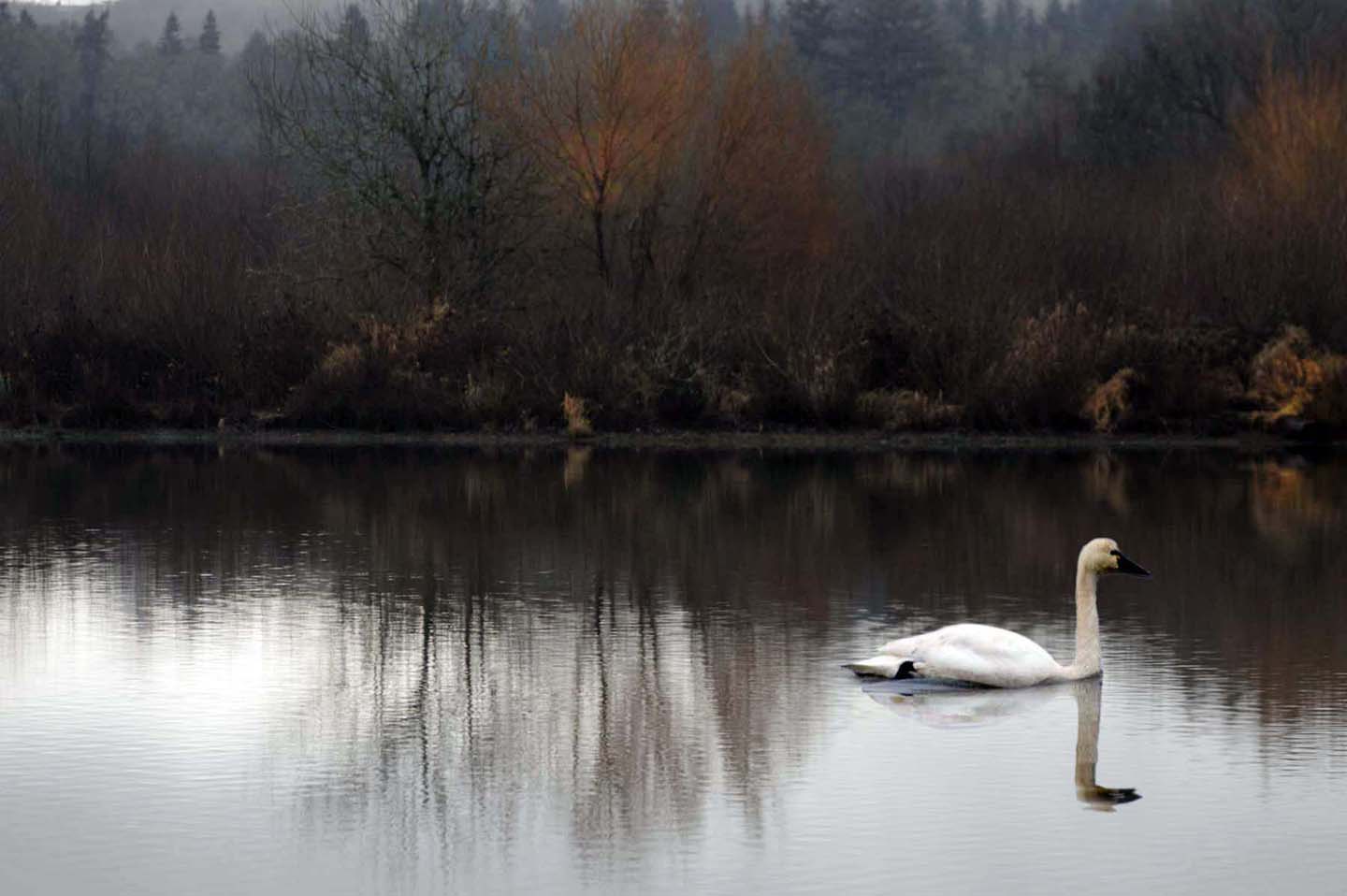The silver Swan, who living had no Note,
when Death approached, unlocked her silent throat.
Leaning her breast against the reedy shore,
thus sang her first and last, and sang no more:
“Farewell, all joys! O Death, come close mine eyes!
“More Geese than Swans now live, more Fools than Wise.””
– Orlando Gibbons The Silver Swan Madrigals & Motets 1612
Walk with me. In the wetlands, before the intense cold, predicted for the days to come, is settling in. The air is damp, a grayish blue that intensifies all the yellows and oranges around, the bark of the willow bushes, the buds of the hazelnut trees. (And also makes it very difficult to photograph birds in flight as you will see below.)





A dreamy landscape, with occasional glimpses of the sun trying to break through the cloud cover







Herons and egrets drying off and combing for morsels, respectively.



Bald eagle on the look-out.

Some geese,


lots of duck action, ducks unknown to me,



some happily (?) planning for future ducklings…



The silence, only occasionally interrupted by their flapping wings, or splashing water, is shattered when a wedge of swans appears overhead in flight, calling loudly.

A sight to behold! These are Tundra swans (Cygnus columbianus sometimes called Whistling swans)), recognizable by their black beaks and slight yellow streak around their eye (I could only see that with the single one I caught close on camera, while swimming.) They are native to North America and we can see them in winter when they fly over Oregon, foraging here in our wetlands.

These swans are monogamous and mate for life (they can live for more than 20 years), breeding once a year in the tundras of Canada and the Alaskan arctic. Come autumn, they merge in groups of up to 100 birds to fly south. The journey covers 4000 miles, flown at an altitude as high as 26.000 feet and with speeds up to 60 mph! Their biology is all about making this flight possible: bones are hollow and there are fewer of them compared to mammals; their breathing systems is adjusted in multiple ways – (during flight birds need to breathe up to 10 times faster to enable sufficient oxygen to be delivered to the muscles. All of these details, btw, I found here.)

The lungs have far more tissue density so that more blood can flow through them for oxygen exchange. Their breath flows in one direction only, entering on one path, exiting on another, enabling lots of volume to flow through in a steady stream. Their windpipe, the trachea, is different from ours’ as well – as you can see in the picture, it has coiled loops at the end, rather than going straight into the lungs.


“Why is she blasting me with all these details?” you might wonder. “Do I really need to know tundra swan anatomy?” Well, you might want to if you are interested in the genesis of the phrase “Swansong,” a phrase commonly used to describe the last output of someone before their stage exit or death, often heard in the context of famous artists showering us with brilliant work at the end of their life. (In fact, music today is Schubert’s collection of songs titled Swansong, published posthumously.)

OK, maybe Swansong is not on the forefront of your thoughts either, but it really is an interesting bit of lore – or, as it turns out, a biological fact.
Throughout history, swans have held a special place in mankind’s imagination. Tons of confabulation revolves around them, from the Greek fables to Norse mythology to the European fairy tales of the 19th century. (Details can be found in this essay, which was also the source of today’s entry citation.) One of the lasting assumptions across cultures was the claim that swans are pretty much silent or mute throughout their life time, and only sing beautifully at the point of their death. Some smart cookies, like Pliny the Elder, were already critical of that observation in CE 77, but the belief would not die. Da Vinci noted it, as did Chaucer, Shakespeare, Tennyson and Coleridge, to mention just a few.

Here is the deal: swans are not mute during their lifetime. But it is also true, that due to the nature of their coiled trachea, they emit a series of long, plaintive tones when their lungs collapse during death and the air gets pushed through the windpipe, probably the base observation that started the legend.

Now where the other piece of persistent lore originates – swans are maidens, who shed their feather coats at night to bathe in the lakes and can be trapped if you steal the plumage – remains a mystery not yet solved by naturalists…


For those less inclined towards biology and more interested in art: Here is a truly terrific collection of 44 art works centered on the myth of Leda and the Swan. The author did an amazing tour de force from Michelangelo to modern photography and everyone in between, with helpful description and discussion of each piece. Really worth a read!








Sara Lee Silberman
A spectacularly rich posting! Even for you, I might say…. I loved the 17th poem. Your photography was magnificent. And the Leda and the Swan art!!!!! Brava in re all!
Louise
This was brilliant and I enjoyed reading it enormously!!